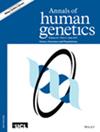Identification of pathogenic deep intronic variant and exonic LINE-1 insertion in a patient with Meckel syndrome
IF 1
4区 生物学
Q4 GENETICS & HEREDITY
引用次数: 0
Abstract
Biallelic CC2D2A variants are associated with a wide range of neurodevelopmental disorders including Meckel syndrome. Here we report a Japanese girl with Meckel syndrome harboring a pathogenic deep intronic variant (NM_001378615.1:c.1149+3569A>G) and an exonic LINE-1 insertion, which was predicted to cause aberrant splicing by SpliceAI and was detected by TEMP2 program, respectively. RNA analysis using urine-derived cells (UDCs) showed retention of 149-bp intronic sequences, leading to frameshift. Immunoblotting showed marked reduction of CC2D2A protein in the patient. Our report demonstrated that utilization of transposon detection tool and functional analysis using UDCs will increase diagnostic yield of genome sequencing.
梅克尔综合征患者致病性深内含子变异和外显子LINE-1插入的鉴定
双等位基因CC2D2A变异与包括梅克尔综合征在内的多种神经发育障碍有关。本文报道了一名日本Meckel综合征女孩,该女孩携带致病性深内含子变异(NM_001378615.1:c.1149+3569A>G)和外显子LINE-1插入,SpliceAI和TEMP2程序分别预测了这两种变异会导致异常剪接。使用尿源性细胞(UDCs)进行RNA分析显示,保留了149 bp的内含子序列,导致移码。免疫印迹显示患者体内CC2D2A蛋白明显减少。我们的报告表明,利用转座子检测工具和UDCs进行功能分析将提高基因组测序的诊出率。
本文章由计算机程序翻译,如有差异,请以英文原文为准。
求助全文
约1分钟内获得全文
求助全文
来源期刊

Annals of Human Genetics
生物-遗传学
CiteScore
4.20
自引率
0.00%
发文量
34
审稿时长
3 months
期刊介绍:
Annals of Human Genetics publishes material directly concerned with human genetics or the application of scientific principles and techniques to any aspect of human inheritance. Papers that describe work on other species that may be relevant to human genetics will also be considered. Mathematical models should include examples of application to data where possible.
Authors are welcome to submit Supporting Information, such as data sets or additional figures or tables, that will not be published in the print edition of the journal, but which will be viewable via the online edition and stored on the website.
 求助内容:
求助内容: 应助结果提醒方式:
应助结果提醒方式:


